Sony A3000 vs A58
The Sony Alpha A3000 and the Sony Alpha SLT-A58 are two digital cameras that were announced, respectively, in August 2013 and February 2013. The A3000 is a mirrorless interchangeable lens camera, while the A58 is a DSLR. Both cameras are equipped with an APS-C sensor. Both cameras offer a resolution of 19.8 megapixels.
Below is an overview of the main specs of the two cameras as a starting point for the comparison.

Check A3000 offers at
ebay.com

Check A58 offers at
ebay.com
Going beyond this snapshot of core features and characteristics, what are the differences between the Sony Alpha A3000 and the Sony Alpha SLT-A58? Which one should you buy? Read on to find out how these two cameras compare with respect to their body size, their imaging sensors, their shooting features, their input-output connections, and their reception by expert reviewers.
Body comparison
An illustration of the physical size and weight of the Sony A3000 and the Sony A58 is provided in the side-by-side display below. The two cameras are presented according to their relative size. Three consecutive views from the front, the top, and the rear side are shown. All size dimensions are rounded to the nearest millimeter.
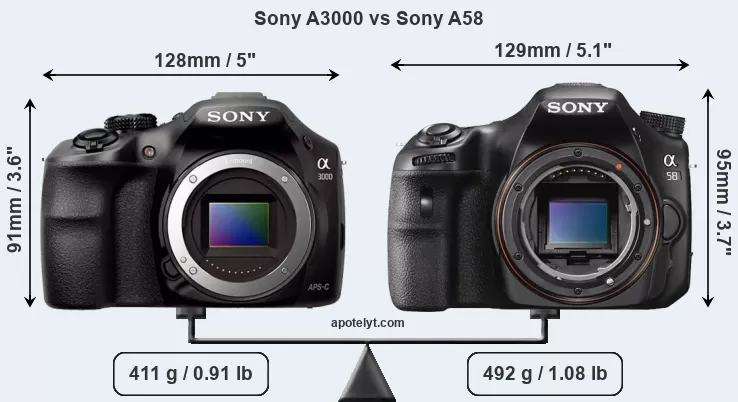
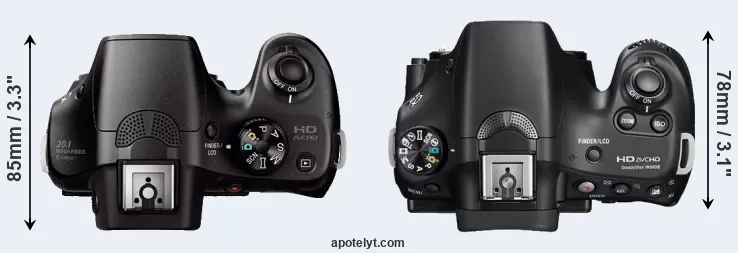
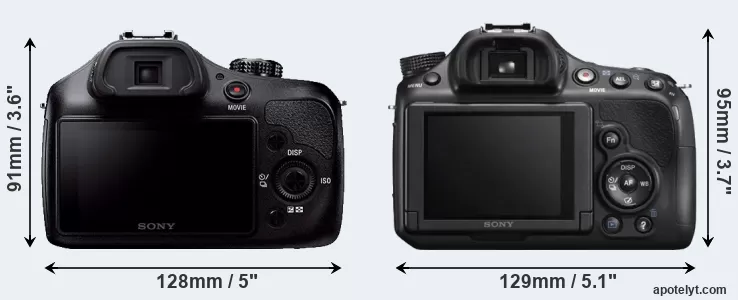
If the front view area (width x height) of the cameras is taken as an aggregate measure of their size, the Sony A58 is notably larger (5 percent) than the Sony A3000. Moreover, the A58 is markedly heavier (20 percent) than the A3000. In this context, it is worth noting that neither the A3000 nor the A58 are weather-sealed.
The above size and weight comparisons are to some extent incomplete since they do not consider the interchangeable lenses that both of these cameras require. Hence, you might want to study and compare the specifications of available lenses in order to get the full picture of the size and weight of the two camera systems.
Concerning battery life, the A3000 gets 470 shots out of its Sony NP-FW50 battery, while the A58 can take 690 images on a single charge of its Sony NP-FM500H power pack. The power pack in the A3000 can be charged via the USB port, so that it is not always necessary to take the battery charger along when travelling.
The following table provides a synthesis of the main physical specifications of the two cameras and other similar ones. If you would like to visualize and compare a different camera combination, you can navigate to the CAM-parator app and make your selection from a broad list of cameras there.

| Camera Model |
Camera Width |
Camera Height |
Camera Depth |
Camera Weight |
Battery Life |
Weather Sealing |
Camera Launch |
Launch Price (USD) |
Street Price |
||
|---|---|---|---|---|---|---|---|---|---|---|---|
| 1. | Sony A3000 | 128 mm | 91 mm | 85 mm | 411 g | 470 | n | Aug 2013 | 329 | ebay.com | |
| 2. | Sony A58 | 129 mm | 95 mm | 78 mm | 492 g | 690 | n | Feb 2013 | 599 | ebay.com | |
| 3. | Nikon D3200 | 125 mm | 96 mm | 77 mm | 505 g | 540 | n | Apr 2012 | 599 | ebay.com | |
| 4. | Sony A68 | 143 mm | 104 mm | 81 mm | 610 g | 540 | n | Nov 2015 | 699 | ebay.com | |
| 5. | Sony A77 II | 143 mm | 104 mm | 81 mm | 647 g | 480 | Y | May 2014 | 1,199 | ebay.com | |
| 6. | Sony A5000 | 110 mm | 63 mm | 36 mm | 269 g | 420 | n | Jan 2014 | 449 | ebay.com | |
| 7. | Sony A5100 | 110 mm | 63 mm | 36 mm | 283 g | 400 | n | Aug 2014 | 549 | ebay.com | |
| 8. | Sony A6000 | 120 mm | 67 mm | 45 mm | 344 g | 360 | n | Feb 2014 | 599 | ebay.com | |
| 9. | Sony A6400 | 120 mm | 67 mm | 50 mm | 403 g | 410 | Y | Jan 2019 | 899 | amazon.com | |
| 10. | Sony NEX-3N | 110 mm | 62 mm | 35 mm | 269 g | 480 | n | Feb 2013 | 499 | ebay.com | |
| 11. | Sony NEX-6 | 120 mm | 67 mm | 43 mm | 345 g | 360 | n | Sep 2012 | 999 | ebay.com | |
| 12. | Sony NEX-7 | 120 mm | 67 mm | 43 mm | 400 g | 430 | n | Aug 2011 | 1,349 | ebay.com | |
| 13. | Sony RX1 | 113 mm | 65 mm | 70 mm | 482 g | 270 | n | Sep 2012 | 2,799 | ebay.com | |
| 14. | Sony RX1R | 113 mm | 65 mm | 70 mm | 482 g | 270 | n | Jun 2013 | 2,799 | ebay.com | |
| Note: Measurements and pricing do not include easily detachable parts, such as add-on or interchangeable lenses or optional viewfinders. | |||||||||||
Any camera decision will obviously take relative prices into account. The manufacturer’s suggested retail prices give an idea on the placement of the camera in the maker’s lineup and the broader market. The A3000 was launched at a markedly lower price (by 45 percent) than the A58, which puts it into a different market segment. Usually, retail prices stay at first close to the launch price, but after several months, discounts become available. Later in the product cycle and, in particular, when the replacement model is about to appear, further discounting and stock clearance sales often push the camera price considerably down.
Sensor comparison
The size of the imaging sensor is a crucial determinant of image quality. A large sensor will tend to have larger individual pixels that provide better low-light sensitivity, wider dynamic range, and richer color-depth than smaller pixel-units in a sensor of the same technological generation. Further, a large sensor camera will give the photographer additional creative options when using shallow depth-of-field to isolate a subject from its background. On the downside, larger sensors tend to be associated with larger, more expensive camera bodies and lenses.
Both cameras under consideration feature an APS-C sensor, but their sensors differ slightly in size. The sensor area in the A58 is 3 percent bigger. They nevertheless have the same format factor of 1.5. Both cameras have a native aspect ratio (sensor width to sensor height) of 3:2.
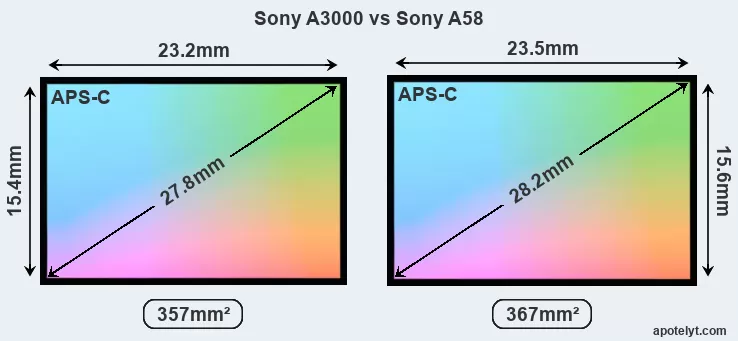
Even though the A58 has a slightly larger sensor, both cameras offer the same resolution of 19.8 megapixels. This implies that the A58 has a lower pixel density and marginally larger individual pixels (with a pixel pitch of 4.31μm versus 4.25μm for the A3000), which gives it a potential advantage in terms of light gathering capacity. It should, however, be noted that the A3000 is a somewhat more recent model (by 6 months) than the A58, and its sensor might have benefitted from technological advances during this time that at least partly compensate for the smaller pixel size.
The Sony Alpha A3000 has a native sensitivity range from ISO 100 to ISO 16000. The corresponding ISO settings for the Sony Alpha SLT-A58 are ISO 100 to ISO 16000, with the possibility to increase the ISO range to 100-25600.
Technology-wise, both cameras are equipped with CMOS (Complementary Metal–Oxide–Semiconductor) sensors. Both cameras use a Bayer filter for capturing RGB colors on a square grid of photosensors. This arrangement is found in most digital cameras.
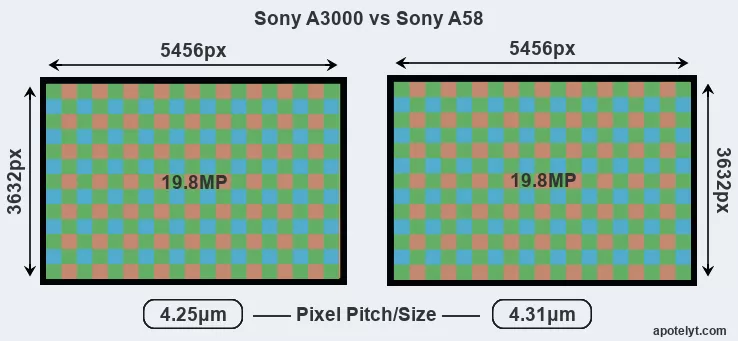
For many cameras, data on sensor performance has been reported by DXO Mark. This service is based on lab testing and assigns an overall score to each camera sensor, as well as ratings for dynamic range ("DXO Landscape"), color depth ("DXO Portrait"), and low-light sensitivity ("DXO Sports"). Of the two cameras under review, the A3000 has a notably higher overall DXO score than the A58 (overall score 4 points higher), which gives it an advantage in terms of imaging quality. This advantage is based on 0.4 bits higher color depth, 0.3 EV in additional dynamic range, and 0.5 stops in additional low light sensitivity. The adjacent table reports on the physical sensor characteristics and the outcomes of the DXO sensor quality tests for a sample of comparator-cameras.

| Camera Model |
Sensor Class |
Resolution (MP) |
Horiz. Pixels |
Vert. Pixels |
Video Format |
DXO Portrait |
DXO Landscape |
DXO Sports |
DXO Overall |
||
|---|---|---|---|---|---|---|---|---|---|---|---|
| 1. | Sony A3000 | APS-C | 19.8 | 5456 | 3632 | 1080/60i | 23.7 | 12.8 | 1068 | 78 | |
| 2. | Sony A58 | APS-C | 19.8 | 5456 | 3632 | 1080/60i | 23.3 | 12.5 | 753 | 74 | |
| 3. | Nikon D3200 | APS-C | 24.1 | 6016 | 4000 | 1080/30p | 24.1 | 13.2 | 1131 | 81 | |
| 4. | Sony A68 | APS-C | 24.0 | 6000 | 4000 | 1080/60i | 24.1 | 13.5 | 701 | 79 | |
| 5. | Sony A77 II | APS-C | 24.0 | 6000 | 4000 | 1080/60p | 24.4 | 13.4 | 1013 | 82 | |
| 6. | Sony A5000 | APS-C | 19.8 | 5456 | 3632 | 1080/60i | 23.8 | 13.0 | 1089 | 79 | |
| 7. | Sony A5100 | APS-C | 24.0 | 6000 | 4000 | 1080/60p | 23.8 | 12.7 | 1347 | 80 | |
| 8. | Sony A6000 | APS-C | 24.0 | 6000 | 4000 | 1080/60p | 24.1 | 13.1 | 1347 | 82 | |
| 9. | Sony A6400 | APS-C | 24.0 | 6000 | 4000 | 4K/30p | 24.0 | 13.6 | 1431 | 83 | |
| 10. | Sony NEX-3N | APS-C | 16.0 | 4912 | 3264 | 1080/60i | 22.8 | 12.5 | 1067 | 74 | |
| 11. | Sony NEX-6 | APS-C | 16.0 | 4912 | 3264 | 1080/60i | 23.7 | 13.1 | 1018 | 78 | |
| 12. | Sony NEX-7 | APS-C | 24.0 | 6000 | 4000 | 1080/60i | 24.1 | 13.4 | 1016 | 81 | |
| 13. | Sony RX1 | Full Frame | 24.0 | 6000 | 4000 | 1080/60p | 25.1 | 14.3 | 2534 | 93 | |
| 14. | Sony RX1R | Full Frame | 24.0 | 6000 | 4000 | 1080/60p | 25.0 | 13.6 | 2537 | 91 |
Many modern cameras are not only capable of taking still images, but can also record movies. The two cameras under consideration both have sensors whose read-out speed is fast enough to capture moving pictures, and both provide the same movie specifications (1080/60i).
Feature comparison
Beyond body and sensor, cameras can and do differ across a range of features. The two cameras under review are similar with respect to both having an electronic viewfinder. However, the one in the A58 offers a substantially higher resolution than the one in the A3000 (1440k vs 202k dots). The adjacent table lists some of the other core features of the Sony A3000 and Sony A58 along with similar information for a selection of comparators.

| Camera Model |
Viewfinder (Type or 000 dots) |
Control Panel (yes/no) |
LCD Specifications (inch/000 dots) |
LCD Attach- ment |
Touch Screen (yes/no) |
Max Shutter Speed * |
Max Shutter Flaps * |
Built-in Flash (yes/no) |
Built-in Image Stab |
||
|---|---|---|---|---|---|---|---|---|---|---|---|
| 1. | Sony A3000 | 202 | n | 3.0 / 230 | fixed | n | 1/4000s | 2.5/s | Y | n | |
| 2. | Sony A58 | 1440 | n | 2.7 / 460 | tilting | n | 1/4000s | 5.0/s | Y | Y | |
| 3. | Nikon D3200 | optical | n | 3.0 / 921 | fixed | n | 1/4000s | 4.0/s | Y | n | |
| 4. | Sony A68 | 1440 | Y | 2.7 / 460 | tilting | n | 1/4000s | 8.0/s | Y | Y | |
| 5. | Sony A77 II | 2359 | Y | 3.0 / 1229 | full-flex | n | 1/8000s | 12.0/s | Y | Y | |
| 6. | Sony A5000 | none | n | 3.0 / 461 | tilting | n | 1/4000s | 3.5/s | Y | n | |
| 7. | Sony A5100 | none | n | 3.0 / 922 | tilting | Y | 1/4000s | 6.0/s | Y | n | |
| 8. | Sony A6000 | 1440 | n | 3.0 / 922 | tilting | n | 1/4000s | 11.0/s | Y | n | |
| 9. | Sony A6400 | 2359 | n | 3.0 / 922 | tilting | Y | 1/4000s | 11.0/s | Y | n | |
| 10. | Sony NEX-3N | optional | n | 3.0 / 460 | tilting | n | 1/4000s | 4.0/s | Y | n | |
| 11. | Sony NEX-6 | 2359 | n | 3.0 / 921 | tilting | n | 1/4000s | 10.0/s | Y | n | |
| 12. | Sony NEX-7 | 2359 | n | 3.0 / 921 | tilting | n | 1/4000s | 10.0/s | Y | n | |
| 13. | Sony RX1 | optional | n | 3.0 / 1229 | fixed | n | 1/4000s | 5.0/s | Y | n | |
| 14. | Sony RX1R | optional | n | 3.0 / 1229 | fixed | n | 1/4000s | 5.0/s | Y | n | |
| Note: *) Information refers to the mechanical shutter, unless the camera only has an electronic one. | |||||||||||
One feature that differentiates the A58 and the A3000 is in-body image stabilization (IBIS). The A58 reduces the risk of handshake-induced blur with all attached lenses, while the A3000 offers no blur reduction with lenses that themselves do not provide optical image stabilization.
Concerning the storage of imaging data, both the A3000 and the A58 write their files to SDXC or Memory Stick PRO Duo cards.
Connectivity comparison
For some imaging applications, the extent to which a camera can communicate with its environment can be an important aspect in the camera decision process. The table below provides an overview of the connectivity of the Sony Alpha A3000 and Sony Alpha SLT-A58 and, in particular, the interfaces the cameras (and selected comparators) provide for accessory control and data transfer.

| Camera Model |
Hotshoe Port |
Internal Mic / Speaker |
Microphone Port |
Headphone Port |
HDMI Port |
USB Port |
WiFi Support |
NFC Support |
Bluetooth Support |
||
|---|---|---|---|---|---|---|---|---|---|---|---|
| 1. | Sony A3000 | Y | stereo / mono | - | - | mini | 2.0 | - | - | - | |
| 2. | Sony A58 | Y | stereo / mono | Y | - | mini | 2.0 | - | - | - | |
| 3. | Nikon D3200 | Y | mono / mono | Y | - | mini | 2.0 | - | - | - | |
| 4. | Sony A68 | Y | stereo / mono | Y | - | micro | 2.0 | - | - | - | |
| 5. | Sony A77 II | Y | stereo / mono | Y | - | mini | 2.0 | Y | Y | - | |
| 6. | Sony A5000 | - | stereo / mono | - | - | micro | 2.0 | Y | Y | - | |
| 7. | Sony A5100 | - | stereo / mono | - | - | micro | 2.0 | Y | Y | - | |
| 8. | Sony A6000 | Y | stereo / mono | - | - | micro | 2.0 | Y | Y | - | |
| 9. | Sony A6400 | Y | stereo / mono | Y | - | micro | 2.0 | Y | Y | Y | |
| 10. | Sony NEX-3N | - | stereo / mono | - | - | micro | 2.0 | - | - | - | |
| 11. | Sony NEX-6 | Y | stereo / mono | - | - | mini | 2.0 | Y | - | - | |
| 12. | Sony NEX-7 | Y | stereo / mono | Y | - | mini | 2.0 | - | - | - | |
| 13. | Sony RX1 | Y | stereo / mono | Y | - | mini | 2.0 | - | - | - | |
| 14. | Sony RX1R | Y | stereo / mono | Y | - | mini | 2.0 | - | - | - |
It is notable that the A58 has a microphone port, which can help to improve the quality of audio recordings by attaching an external microphone. The A3000 does not feature such a mic input.
Both the A3000 and the A58 have been discontinued, but can regularly be found used on ebay. The A58 was replaced by the Sony A68, while the A3000 does not have a direct successor. Further information on the features and operation of the A3000 and A58 can be found, respectively, in the Sony A3000 Manual (free pdf) or the online Sony A58 Manual.
Review summary
So what conclusions can be drawn? Is the Sony A3000 better than the Sony A58 or vice versa? The listing below highlights the relative strengths of the two models.
Arguments in favor of the Sony Alpha A3000:
- Better image quality: Scores markedly higher (4 points) in the DXO overall assessment.
- Better low-light sensitivity: Requires less light for good images (0.5 stops ISO advantage).
- Larger screen: Has a bigger rear LCD (3.0" vs 2.7") for image review and settings control.
- Less heavy: Is lighter (by 81g or 16 percent) and hence easier to carry around.
- Easier travel charging: Can be conveniently charged via its USB port.
- More legacy lens friendly: Can take a broad range of non-native lenses via adapters.
- More affordable: Was introduced into a lower priced category (45 percent cheaper at launch).
- More modern: Is somewhat more recent (announced 6 months after the A58).
Advantages of the Sony Alpha SLT-A58:
- Better sound: Can connect to an external microphone for higher quality sound recording.
- More detailed viewfinder: Has higher resolution electronic viewfinder (1440k vs 202k dots).
- Larger viewfinder image: Features a viewfinder with a higher magnification (0.57x vs 0.47x).
- More detailed LCD: Has a higher resolution rear screen (460k vs 230k dots).
- More flexible LCD: Has a tilting screen for odd-angle shots in landscape orientation.
- Faster burst: Shoots at higher frequency (5 vs 2.5 flaps/sec) to capture the decisive moment.
- Longer lasting: Gets more shots (690 versus 470) out of a single battery charge.
- Sharper images: Has stabilization technology built-in to reduce the impact of hand-shake.
- More heavily discounted: Has been on the market for longer (launched in February 2013).
If the count of relative strengths (bullet points above) is taken as a measure, the A58 comes out slightly ahead of the A3000 (9 : 8 points). However, the pertinence of the various camera strengths will differ across photographers, so that you might want to weigh individual camera traits according to their importance for your own imaging needs before making a camera decision. A professional wildlife photographer will view the differences between cameras in a way that diverges from the perspective of a family photog, and a person interested in architecture has distinct needs from a sports shooter. Hence, the decision which camera is best and worth buying is often a very personal one.
How about other alternatives? Do the specifications of the Sony A3000 and the Sony A58 place the cameras among the top in their class? Find out in the latest Best Mirrorless Interchangeable Lens Camera and Best DSLR Camera listings whether the two cameras rank among the cream of the crop.
In any case, while the comparison of technical specifications can provide a useful overview of the capabilities of different cameras, it remains partial and cannot reveal, for example, the shooting experience and imaging performance when actually working with the A3000 or the A58. User reviews that are available, for instance, at amazon can sometimes shed light on these issues, but such feedback is all too often partial, inconsistent, and inaccurate.
Expert reviews
This is why expert reviews are important. The following table reports the overall ratings of the cameras as published by some of the major camera review sites (amateurphotographer [AP], cameralabs [CL], digitalcameraworld [DCW], dpreview [DPR], ephotozine [EPZ], photographyblog [PB]). As can be seen, the professional reviewers agree in many cases on the quality of different cameras, but sometimes their assessments diverge, reinforcing the earlier point that a camera decision is often a very personal choice.

| Camera Model |
AP score |
CL score |
DCW score |
DPR score |
EPZ score |
PB score |
Camera Launch |
Launch Price (USD) |
Street Price |
||
|---|---|---|---|---|---|---|---|---|---|---|---|
| 1. | Sony A3000 | 3/5 | + | .. | .. | 4/5 | 4/5 | Aug 2013 | 329 | ebay.com | |
| 2. | Sony A58 | 3/5 | .. | .. | .. | 4.5/5 | 4.5/5 | Feb 2013 | 599 | ebay.com | |
| 3. | Nikon D3200 | 5/5 | + + | .. | 73/100 | 4.5/5 | 4.5/5 | Apr 2012 | 599 | ebay.com | |
| 4. | Sony A68 | 3/5 | .. | .. | .. | 4/5 | 4/5 | Nov 2015 | 699 | ebay.com | |
| 5. | Sony A77 II | 4/5 | .. | .. | 80/100 | 4.5/5 | 5/5 | May 2014 | 1,199 | ebay.com | |
| 6. | Sony A5000 | 3/5 | + | .. | .. | 4.5/5 | 4.5/5 | Jan 2014 | 449 | ebay.com | |
| 7. | Sony A5100 | 4.5/5 | + | .. | .. | 4.5/5 | 5/5 | Aug 2014 | 549 | ebay.com | |
| 8. | Sony A6000 | 5/5 | + | 4.5/5 | 80/100 | 4.5/5 | 5/5 | Feb 2014 | 599 | ebay.com | |
| 9. | Sony A6400 | 4/5 | + | 4/5 | 85/100 | 4.5/5 | 4/5 | Jan 2019 | 899 | amazon.com | |
| 10. | Sony NEX-3N | 3/5 | .. | .. | .. | 4.5/5 | 4.5/5 | Feb 2013 | 499 | ebay.com | |
| 11. | Sony NEX-6 | 5/5 | + + | .. | 78/100 | 4.5/5 | 4.5/5 | Sep 2012 | 999 | ebay.com | |
| 12. | Sony NEX-7 | 5/5 | + + | .. | 81/100 | 4.5/5 | 5/5 | Aug 2011 | 1,349 | ebay.com | |
| 13. | Sony RX1 | 5/5 | .. | .. | 79/100 | 4/5 | 4.5/5 | Sep 2012 | 2,799 | ebay.com | |
| 14. | Sony RX1R | 5/5 | .. | .. | .. | 4/5 | 4.5/5 | Jun 2013 | 2,799 | ebay.com | |
| Note: (+ +) highly recommended; (+) recommended; (o) reviewed; (..) not available. | |||||||||||
The above review scores should be interpreted with care, though. The ratings were established in reference to similarly priced cameras that were available in the market at the time of the review. Hence, a score should always be seen in the context of the camera's market launch date and its price, and comparing ratings of very distinct cameras or ones that are far apart in terms of their release date have little meaning. It should also be noted that some of the review sites have over time altered the way they render their verdicts.

Check A3000 offers at
ebay.com

Check A58 offers at
ebay.com
Other camera comparisons
Did this review help to inform your camera decision process? In case you are interested in seeing how other cameras pair up, just make a corresponding selection in the search boxes below. There is also a set of direct links to comparison reviews that other users of the CAM-parator app explored.
Specifications: Sony A3000 vs Sony A58
Below is a side-by-side comparison of the specs of the two cameras to facilitate a quick review of their differences and common features.
| Camera Model | Sony A3000 | Sony A58 |
|---|---|---|
| Camera Type | Mirrorless system camera | Digital single lens reflex |
| Camera Lens | Sony E mount lenses | Sony A mount lenses |
| Launch Date | August 2013 | February 2013 |
| Launch Price | USD 329 | USD 599 |
| Sensor Specs | Sony A3000 | Sony A58 |
| Sensor Technology | CMOS | CMOS |
| Sensor Format | APS-C Sensor | APS-C Sensor |
| Sensor Size | 23.2 x 15.4 mm | 23.5 x 15.6 mm |
| Sensor Area | 357.28 mm2 | 366.6 mm2 |
| Sensor Diagonal | 27.8 mm | 28.2 mm |
| Crop Factor | 1.5x | 1.5x |
| Sensor Resolution | 19.8 Megapixels | 19.8 Megapixels |
| Image Resolution | 5456 x 3632 pixels | 5456 x 3632 pixels |
| Pixel Pitch | 4.25 μm | 4.31 μm |
| Pixel Density | 5.55 MP/cm2 | 5.41 MP/cm2 |
| Moiré control | Anti-Alias filter | Anti-Alias filter |
| Movie Capability | 1080/60i Video | 1080/60i Video |
| ISO Setting | 100 - 16,000 ISO | 100 - 16,000 ISO |
| ISO Boost | no Enhancement | 100 - 25,600 ISO |
| Image Processor | BIONZ | BIONZ |
| DXO Sensor Quality (score) | 78 | 74 |
| DXO Color Depth (bits) | 23.7 | 23.3 |
| DXO Dynamic Range (EV) | 12.8 | 12.5 |
| DXO Low Light (ISO) | 1068 | 753 |
| Screen Specs | Sony A3000 | Sony A58 |
| Viewfinder Type | Electronic viewfinder | Electronic viewfinder |
| Viewfinder Field of View | 100% | 100% |
| Viewfinder Magnification | 0.47x | 0.57x |
| Viewfinder Resolution | 202k dots | 1440k dots |
| LCD Framing | Live View | Live View |
| Rear LCD Size | 3.0inch | 2.7inch |
| LCD Resolution | 230k dots | 460k dots |
| LCD Attachment | Fixed screen | Tilting screen |
| Shooting Specs | Sony A3000 | Sony A58 |
| Focus System | Contrast-detect AF | Phase-detect AF |
| Manual Focusing Aid | Focus Peaking | Focus Peaking |
| Max Shutter Speed (mechanical) | 1/4000s | 1/4000s |
| Continuous Shooting | 2.5 shutter flaps/s | 5 shutter flaps/s |
| Image Stabilization | Lens stabilization only | In-body stabilization |
| Fill Flash | Built-in Flash | Built-in Flash |
| Storage Medium | MS or SDXC cards | MS or SDXC cards |
| Single or Dual Card Slots | Single card slot | Single card slot |
| UHS card support | no | no |
| Connectivity Specs | Sony A3000 | Sony A58 |
| External Flash | Hotshoe | Hotshoe |
| USB Connector | USB 2.0 | USB 2.0 |
| HDMI Port | mini HDMI | mini HDMI |
| Microphone Port | no MIC socket | External MIC port |
| Wifi Support | no Wifi | no Wifi |
| Body Specs | Sony A3000 | Sony A58 |
| Battery Type | Sony NP-FW50 | Sony NP-FM500H |
| Battery Life (CIPA) | 470 shots per charge | 690 shots per charge |
| In-Camera Charging | USB charging | no USB charging |
| Body Dimensions |
128 x 91 x 85 mm (5.0 x 3.6 x 3.3 in) |
129 x 95 x 78 mm (5.1 x 3.7 x 3.1 in) |
| Camera Weight | 411 g (14.5 oz) | 492 g (17.4 oz) |

Check A3000 offers at
ebay.com

Check A58 offers at
ebay.com
Did you notice an error on this page? If so, please get in touch, so that we can correct the information.

